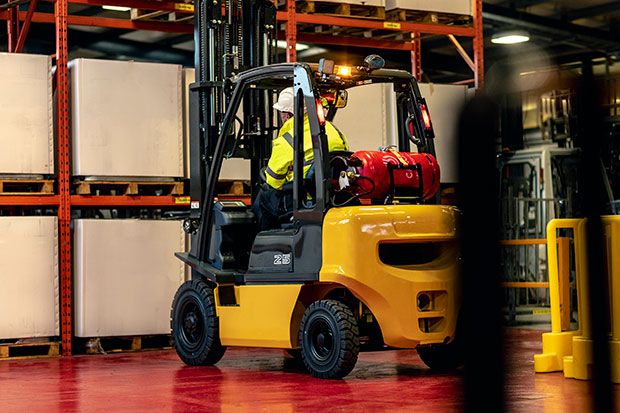Productivity is key to a company’s profitability and long-term success. It measures how much output a company can produce, impacting profit, employee retention and business growth. In fact, unproductive workforces cost British businesses a total of £143 billion each year and UK warehouses, in particular, have been found to waste 3,000 hours a year on poor processes.
 A big factor that affects productivity in warehouses is downtime. When a piece of machinery is out of use or under repair, productivity is limited, and the entire production and supply process takes a hit. A major cost that every material handling professional wants to avoid is the cost of downtime.
A big factor that affects productivity in warehouses is downtime. When a piece of machinery is out of use or under repair, productivity is limited, and the entire production and supply process takes a hit. A major cost that every material handling professional wants to avoid is the cost of downtime.
Protecting productivity
Despite growing pressure to cut costs and the need to find efficiency gains, UK warehouse managers reportedly lose up to 3,000 hours a year due to inefficient processes. Added to this is the need to be more resourceful – which can potentially cut costs if done correctly – and the demand to be more sustainable; a change which is often correlated with potentially higher expenditure.
There are easy ways to save money and elevate productivity while ticking the sustainable and resourcefulness box, however. Observing current workflow processes and equipment is a very simple way to pick out what is potentially costing you more time and money.
FLT’s downtime vs sustainability
As well as the obvious cost of repairs, new parts or new vehicles, forklift truck (FLT) downtime can result in staff overtime to overcome the lost time spent on waiting for FLTs, a loss of reputation through delays and knock-on effects further down the supply chain. The bottom line is that FLT downtime is a costly problem for warehouse businesses.
Over the years, FLTs have changed dramatically to meet new demands. There is now added pressure to keep the supply chain process efficient, to keep up with the pace and demand of delivery, particularly in the era of the e-commerce boom during and post pandemic. The UK’s ambitious net zero carbon target has also brought into focus the need to make changes to reduce our carbon footprint. But for many businesses, remaining cost-effective and operationally efficient in such a competitive sector proves to be a challenge.
Although 54% of those surveyed in our report recognised that carbon reduction is a very important consideration when choosing how their FLT fleets should be fuelled, the truth is, this must be juggled with other operational and commercial priorities.
The basics of good fleet management haven’t changed, however, and with the rise in demand to tackle net zero, while keeping downtime at bay, warehouse operators have a big question on their hands: how do they become more sustainable without impacting their processes, productivity, output and downtime?
The challenge with going electric
To tackle the sustainability agenda, for example, electric FLTs have become more popular. Great for reducing carbon emissions, electric FLTs can help improve the air quality on sites and protect workers and potentially look after their ears due to the quietness of electric vehicles.
But there is one key thing to consider: electric FLTs come with a consistent need for downtime due to continual charging after use. Charging, regular equipment checks, and maintenance could represent quite a change from how your fleet currently operates, potentially causing a significant rise in downtime.
Typically, most electric forklift batteries take eight hours to fully charge, however, it is recommended to follow the 8-8-8 Rule: 8 hours of operation, 8 hours of charging, and 8 hours of cooling. This means 16 of the 24 hours are taken up on downtime; a huge cost and hit on productivity for warehouse operations.
The option of Calor Futuria Liquid Gas
To be more sustainable and to impactfully reduce carbon emissions, a good alternative is Calor Futuria Liquid Gas (previously BioLPG). It is a sustainable fuel made from a blend of waste, residues, and sustainably sourced materials and brings impressive carbon reductions when compared to diesel and conventional LPG.
Using a mix of 40% Futuria Liquid Gas and 60% conventional LPG, businesses can reduce carbon emissions by up to 48% (kgCO2e/kWh) compared to using diesel and 33% when compared to conventional LPG. In addition, FLT fleets currently using diesel as a fuel, can also reduce particulate matter by up to 98%, by switching to Futuria Liquid Gas.
Where performance is important, FLTs fuelled by Futuria Liquid Gas have superior travel speeds, rate of acceleration and lift speeds to electric counterparts. Futuria Liquid Gas fuelled FLTs can also perform consistently outdoors, including in colder climates and are reliable when it comes to refuelling, which only takes a few minutes, after which the FLT can return to full operation – allowing efficiency to keep up with operational demand. And when using Futuria Liquid Gas there is less need for the regular maintenance of an electric battery, meaning less downtime throughout the day.
The Futuria with Calor
As part of its commitment to offer its customers 100% sustainable energy solutions by 2040, Calor is taking steps to encourage the switch of all its FLT customers over to its Calor Futuria Liquid Gas tariff, while still keeping in mind the importance of maintaining productivity and not impacting operational processes.
With industry collaboration and government backing, the use of sustainable fuels to power FLTs can play a greater part in achieving the net zero carbon target.
To find out how Calor can help you reach sustainability targets with Calor Futuria Liquid Gas, visit www.calor.co.uk/flt. To find out more about the Green Gas Certification Scheme, visit www.greengas.org.uk.




Comments are closed.